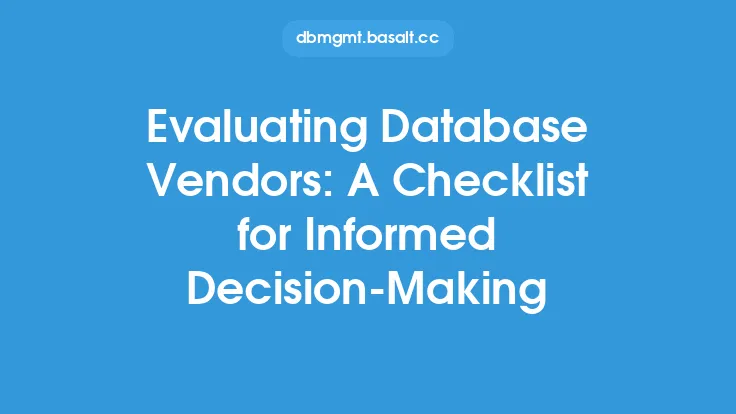Data aggregation is a crucial process in data analysis that involves collecting and combining data from multiple sources into a single, unified view. This process enables organizations to gain a deeper understanding of their data, identify trends and patterns, and make informed decisions. At its core, data aggregation is about transforming raw data into meaningful information that can be used to drive business outcomes.
What is Data Aggregation?
Data aggregation is the process of gathering and combining data from multiple sources, such as databases, spreadsheets, or external data providers. This data is then processed and transformed into a summarized format, making it easier to analyze and understand. Data aggregation can be performed using various techniques, including grouping, filtering, and sorting. The goal of data aggregation is to provide a comprehensive view of the data, highlighting key trends, patterns, and insights that can inform business decisions.
Benefits of Data Aggregation
The benefits of data aggregation are numerous and significant. By aggregating data from multiple sources, organizations can gain a more complete understanding of their business, customers, and market trends. Data aggregation enables organizations to identify areas of improvement, optimize business processes, and make data-driven decisions. Additionally, data aggregation can help organizations to reduce costs, improve efficiency, and enhance customer satisfaction. Some of the key benefits of data aggregation include:
- Improved data quality and accuracy
- Enhanced data analysis and insights
- Better decision-making capabilities
- Increased efficiency and productivity
- Reduced costs and improved resource allocation
Types of Data Aggregation
There are several types of data aggregation, each with its own unique characteristics and applications. Some of the most common types of data aggregation include:
- Rollup aggregation: This type of aggregation involves combining data from multiple sources into a single, summarized view. Rollup aggregation is commonly used in data warehousing and business intelligence applications.
- Cube aggregation: This type of aggregation involves creating a multidimensional view of the data, enabling organizations to analyze data from multiple perspectives. Cube aggregation is commonly used in data analysis and reporting applications.
- Grouping sets aggregation: This type of aggregation involves grouping data into sets based on specific criteria, such as customer demographics or sales regions. Grouping sets aggregation is commonly used in data analysis and reporting applications.
Data Aggregation Techniques
There are several data aggregation techniques that can be used to combine and analyze data. Some of the most common techniques include:
- Summarization: This technique involves summarizing data into a single value, such as a total or average.
- Grouping: This technique involves grouping data into categories based on specific criteria, such as customer demographics or sales regions.
- Filtering: This technique involves filtering data to exclude or include specific data points based on certain criteria.
- Sorting: This technique involves sorting data in a specific order, such as alphabetical or numerical order.
Data Aggregation Tools and Technologies
There are several data aggregation tools and technologies available, each with its own unique features and capabilities. Some of the most common data aggregation tools and technologies include:
- Data warehousing platforms: These platforms provide a centralized repository for storing and analyzing data from multiple sources.
- Business intelligence tools: These tools provide a range of data analysis and reporting capabilities, including data aggregation and visualization.
- Data integration platforms: These platforms provide a range of data integration and aggregation capabilities, including data transformation and mapping.
- Big data analytics platforms: These platforms provide a range of data analysis and aggregation capabilities, including data processing and machine learning.
Challenges and Limitations of Data Aggregation
While data aggregation is a powerful tool for gaining insights and making informed decisions, there are several challenges and limitations to consider. Some of the most common challenges and limitations include:
- Data quality issues: Poor data quality can significantly impact the accuracy and reliability of aggregated data.
- Data integration challenges: Integrating data from multiple sources can be complex and time-consuming.
- Scalability issues: Large datasets can be difficult to aggregate and analyze, requiring significant computational resources.
- Security and privacy concerns: Aggregating sensitive data can raise security and privacy concerns, requiring careful consideration and mitigation.
Best Practices for Data Aggregation
To get the most out of data aggregation, it's essential to follow best practices for data aggregation. Some of the most important best practices include:
- Define clear goals and objectives: Clearly define what you want to achieve through data aggregation, and ensure that your goals and objectives are aligned with your business strategy.
- Ensure data quality: Ensure that your data is accurate, complete, and consistent, and take steps to address any data quality issues.
- Choose the right tools and technologies: Choose data aggregation tools and technologies that meet your needs and requirements, and ensure that they are scalable and flexible.
- Monitor and evaluate performance: Monitor and evaluate the performance of your data aggregation processes, and make adjustments as needed to ensure that you are getting the most out of your data.





